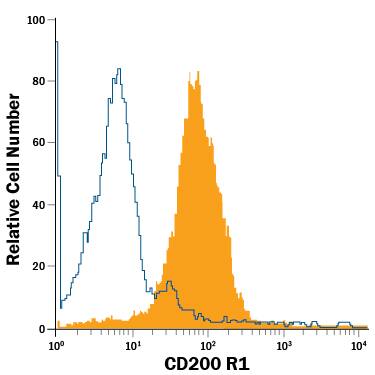Mouse CD200 R1 APC-conjugated Antibody
Mouse CD200 R1 APC-conjugated Antibody Summary
Thr26-Pro238
Accession # BAE42266
Applications
Please Note: Optimal dilutions should be determined by each laboratory for each application. General Protocols are available in the Technical Information section on our website.
Scientific Data
 View Larger
View Larger
Detection of CD200 R1 in MC/9‑2 Mouse Cell Line by Flow Cytometry. MC/9-2 mouse mast cell line was stained with Goat Anti-Mouse CD200 R1 APC-conjugated Antigen Affinity-purified Polyclonal Antibody (Catalog # FAB2554A, filled histogram) or isotype control antibody (Catalog # IC108A, open histogram). View our protocol for Staining Membrane-associated Proteins.
Reconstitution Calculator
Preparation and Storage
Background: CD200R1
CD200 R1, also known as OX-2 receptor, is a 90 kDa, type I transmembrane protein that belongs to the immunoglobulin superfamily. CD200 R1 is important in the regulation of myeloid cell activity (1‑3). The mouse CD200 R1 cDNA encodes a 326 aa precursor that includes a 25 aa signal sequence, a 213 aa extracellular domain (ECD), a 21 aa transmembrane segment, and a 67 aa cytoplasmic domain. The ECD is composed of one Ig-like V-type domain and one Ig-like C2-type domain (4). Within the ECD, mouse CD200 R1 shares 56% and 70% aa sequence identity with human and rat CD200 R1, respectively. The ECD of mouse CD200 R1 shares 69%, 38%, 79%, and 83% aa sequence identity with the ECD of CD200 R2, 3, 4, and a CD200 R-like molecule, respectively. CD200 R1 is expressed primarily on mast cells, basophils, macrophages, and dendritic cells, (5‑7) while its ligand, CD200, is widely distributed (8). Disruption of this receptor-ligand pair by knockout of the CD200 gene leads to increased macrophage number and activation, plus a predisposition to autoimmune disorders (9). Association of CD200 with CD200 R1 takes place between their respective N-terminal Ig-like domains (10). The CD200 R-like molecules may interact differently with CD200 (11, 12). The cytoplasmic domain of CD200 R1 contains two non-ITIM tyrosine residues which are required for propagating its inhibitory signals (13‑15). CD200 R-like molecules, in contrast, are potentially activating receptors by means of their association with DAP12 (4, 16).
- Rosenblum, M.D. et al. (2006) J. Dermatol. Sci. 41:165.
- Gorczynski, R.M. (2005) Curr. Opin. Invest. Drugs 6:483.
- Barclay, A.N. et al. (2002) Trends Immunol. 23:285.
- Wright, G.J. et al. (2003) J. Immunol. 171:3034.
- Shiratori, I. et al. (2005) J. Immunol. 175:4441.
- Cherwinski, H.M. et al. (2005) J. Immunol. 174:1348.
- Fallarino, F. et al. (2004) J. Immunol. 173:3748.
- Wright, G.J. et al. (2001) Immunology 102:173.
- Hoek, R.M. et al. (2000) Science 290:1768.
- Hatherley, D. and A.N. Barclay (2004) Eur. J. Immunol. 34:1688.
- Hatherley, D. et al. (2005) J. Immunol. 175:2469.
- Gorczynski, R. et al. (2004) J. Immunol. 172:7744.
- Zhang, S. and J.H. Phillips (2006) J. Leukoc. Biol. 79:363.
- Zhang, S. et al. (2004) J. Immunol. 173:6786.
- Jenmalm, M.C. et al. (2006) J. Immunol. 176:191.
- Voehringer, D. et al. (2004) J. Biol. Chem. 279:54117.
Product Datasheets
FAQs
No product specific FAQs exist for this product, however you may
View all Antibody FAQsReviews for Mouse CD200 R1 APC-conjugated Antibody
There are currently no reviews for this product. Be the first to review Mouse CD200 R1 APC-conjugated Antibody and earn rewards!
Have you used Mouse CD200 R1 APC-conjugated Antibody?
Submit a review and receive an Amazon gift card.
$25/€18/£15/$25CAN/¥75 Yuan/¥2500 Yen for a review with an image
$10/€7/£6/$10 CAD/¥70 Yuan/¥1110 Yen for a review without an image

